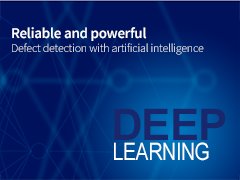How does it work?
MBJ Solutions provides a pre-trained neural network that reliably detects and classifies typical defects such as micro-cracks, dark areas and soldering defects.
Why is it better?
Neural networks are more reliable at detecting defects while significantly reducing the pseudo defect rate.
Strikingly, artificial intelligence is additionally very robust to variations in the cell material. The time-consuming and error-prone optimization of image processing parameters is completely eliminated. Only additional sample images are required for optimization.
In contrast to classical image processing, the artificial intelligence can be extended with little effort to include further defect classes according to customer requirements. Just a few sample images are enough to create a new defect class.
The customer compiles a sample catalog of images in the low two-digit range according to his requirements. He marks the defects in these images. The neural network is optimized with these new examples and the learned network can be used in the customer system.
What does the customer say?
Jun Hong, Process Engineer at REC Group: “MBJ's evaluation software has once again improved significantly through the use of Deep Learning. Especially the automatic smart wire detection and examination based on Deep Learning is a really helpful feature.”
Engineer Rene Battistutti, CEO at Energetica, Austria: “In an Industry 4.0 zero-emission factory, we need the highest level of automation that is technically possible. With the artificial intelligence developed by MBJ for the EL testers, we are able to objectively assess the quality of our products without human compromise. This enables us to achieve the highest process stability with the lowest manpower requirements.”


